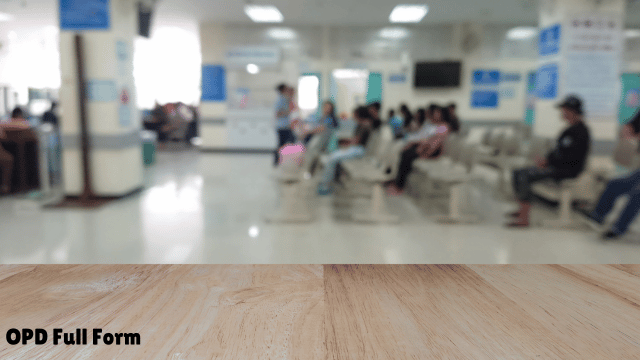Healthcare systems are designed to provide a range of services to meet the diverse needs of patients. One of the most common terms encountered in hospitals and clinics is OPD. But what exactly does OPD stand for, and why is it so integral to healthcare? This comprehensive guide will explore the full form of OPD, its functions, and its importance in medical services.
What Does OPD Stand For?
Full Form of OPD
OPD stands for Outpatient Department. It is a section of a hospital or clinic where patients receive medical consultations, diagnoses, and treatments without being admitted to the hospital. In an OPD, patients come for a scheduled visit, meet with a healthcare provider, and then leave after the consultation or minor procedure.
Difference Between OPD and Inpatient Services
The key difference between OPD and inpatient services is the need for hospital admission. In an OPD, patients receive treatment and return home the same day, while inpatient services require the patient to be admitted for more intensive care, typically involving overnight stays.
Functions of an OPD
Medical Consultations
One of the primary functions of an OPD is to provide medical consultations. Patients visit the OPD to consult with specialists or general practitioners about their health concerns. This may include routine check-ups, follow-up visits after treatment, or consultations for new symptoms.
Diagnostic Services
OPDs often provide diagnostic services, such as blood tests, X-rays, and other imaging procedures. These tests help healthcare providers diagnose conditions accurately without the need for the patient to stay in the hospital.
Minor Procedures
In addition to consultations and diagnostics, some OPDs are equipped to perform minor procedures, such as dressing wounds, administering injections, or conducting minor surgeries that do not require extensive post-operative care.
Preventive Healthcare
OPDs also play a vital role in preventive healthcare. This includes services like vaccinations, health education, and routine screenings that help prevent diseases and detect them early when they are more manageable.
Importance of OPD in Healthcare
Accessibility and Convenience
One of the main advantages of OPD services is accessibility. Patients can visit an OPD without the need for hospital admission, making it a convenient option for those seeking medical advice or treatment for non-emergency conditions. OPDs are often the first point of contact for patients within the healthcare system.
Cost-Effective Care
OPD services are generally more cost-effective than inpatient care because they do not involve the expenses associated with hospital stays. This makes OPDs an attractive option for patients and healthcare systems, especially in resource-limited settings.
Continuity of Care
OPDs are crucial for providing continuity of care. Patients with chronic conditions, such as diabetes or hypertension, require regular monitoring and management, which is often provided through OPD visits. This continuity helps in managing diseases effectively and preventing complications.
Managing Patient Flow
OPDs help in managing patient flow within hospitals by providing a separate area for outpatient services. This segregation ensures that only patients who need intensive care or hospitalization are admitted, thereby optimizing the use of hospital resources.
Types of OPD Services
General OPD
A General OPD caters to patients with common ailments and non-specific symptoms. It is usually staffed by general practitioners or family physicians who provide initial consultations and may refer patients to specialists if necessary.
Specialty OPD
Specialty OPDs focus on specific medical fields, such as cardiology, orthopedics, dermatology, or gynecology. Patients are referred to these OPDs for specialized care after an initial consultation in a General OPD or by a primary care provider.
Emergency OPD
An Emergency OPD, often part of an emergency department, provides immediate care to patients with urgent medical conditions that do not require hospital admission. This can include minor injuries, acute infections, or sudden but manageable symptoms.
Pediatric OPD
Pediatric OPDs specialize in the care of infants, children, and adolescents. These departments offer services ranging from routine check-ups and vaccinations to the treatment of childhood illnesses.
Preventive Health OPD
Preventive Health OPDs focus on preventive services, such as health screenings, vaccinations, and health education. These services are essential for early detection of diseases and promoting overall health and well-being.
The Process of an OPD Visit
Registration
The first step in an OPD visit is registration, where the patient’s details are recorded, and a file is created for the visit. This file helps in tracking the patient’s medical history and the care provided during the visit.
Consultation
After registration, the patient meets with the healthcare provider for a consultation. During this time, the doctor will discuss the patient’s symptoms, medical history, and any previous treatments to diagnose the condition and recommend further steps.
Diagnostic Tests
If necessary, the healthcare provider may order diagnostic tests to gather more information about the patient’s condition. These tests are often conducted within the OPD or in an associated laboratory or imaging center.
Treatment and Follow-Up
Based on the consultation and test results, the healthcare provider will recommend a treatment plan. This may include medication, lifestyle changes, or minor procedures. The patient may also be given a follow-up appointment to monitor progress.
Billing and Payment
Once the consultation and any necessary procedures are completed, the patient will proceed to billing. Payment is made for the services provided during the visit, and the patient receives any prescribed medications from the hospital pharmacy or a local drugstore.
Common Challenges in OPD Services
Long Waiting Times
One of the most common challenges in OPD services is long waiting times, particularly in public hospitals where patient volumes are high. This can lead to patient dissatisfaction and may discourage individuals from seeking timely medical care.
Overcrowding
Overcrowding in OPDs is another significant issue, especially in urban areas. This can strain resources, reduce the quality of care, and increase the risk of infection transmission, particularly in settings where infection control measures are inadequate.
Limited Resources
In some regions, OPDs may struggle with limited resources, including a shortage of healthcare providers, medical equipment, and diagnostic facilities. This can affect the quality of care and the efficiency of services provided.
Coordination of Care
Coordinating care across different specialties and ensuring that patients receive timely follow-ups can be challenging in busy OPDs. Poor coordination can lead to fragmented care, where patients do not receive comprehensive treatment plans or necessary follow-ups.
Improving OPD Services
Streamlining Registration Processes
Improving the registration process can help reduce waiting times and improve patient satisfaction. This can be achieved by implementing online registration systems, appointment scheduling, and better triage systems to prioritize urgent cases.
Expanding OPD Capacity
Expanding the capacity of OPDs by increasing the number of consultation rooms, diagnostic facilities, and healthcare providers can help reduce overcrowding and improve the quality of care.
Enhancing Patient Education
Educating patients about the importance of follow-up visits, medication adherence, and preventive care can improve health outcomes and reduce the need for repeated visits to the OPD.
Implementing Telemedicine
Telemedicine can be an effective way to enhance OPD services, particularly in regions with limited access to healthcare facilities. By providing remote consultations, telemedicine can reduce the burden on physical OPDs and offer patients more convenient access to care.
Improving Coordination of Care
Improving coordination between different specialties and ensuring that patients receive timely referrals and follow-ups can enhance the overall quality of care in OPDs. This can be achieved through better communication systems, integrated electronic health records, and coordinated care teams.
FAQs About OPD
1. What does OPD stand for?
OPD stands for Outpatient Department. It is a section of a hospital or clinic where patients receive consultations, diagnoses, and treatments without being admitted to the hospital.
2. What services are provided in an OPD?
OPD services typically include medical consultations, diagnostic tests, minor procedures, preventive healthcare, and follow-up visits. These services are provided on an outpatient basis, meaning the patient does not stay overnight in the hospital.
3. How does OPD differ from emergency services?
While both OPD and emergency services provide outpatient care, OPD services are generally for non-urgent medical needs, such as routine check-ups or chronic condition management. In contrast, emergency services deal with acute medical conditions that require immediate attention.
4. Can I visit an OPD without an appointment?
In many hospitals and clinics, you can visit an OPD without an appointment, although having an appointment can help reduce waiting times. Some specialty OPDs may require referrals or appointments in advance.
5. Are OPD services covered by health insurance?
Coverage for OPD services varies depending on the health insurance plan. Some plans cover outpatient consultations, diagnostic tests, and minor procedures, while others may have limited coverage or require additional riders.
Conclusion
The Outpatient Department (OPD) plays a crucial role in healthcare, providing accessible, cost-effective, and convenient medical services to patients. Whether for routine check-ups, diagnostic tests, or minor procedures, OPDs are often the first point of contact within the healthcare system. By understanding the full form of OPD and its functions, patients can better navigate their healthcare needs and make informed decisions about their care. As healthcare continues to evolve, improving OPD services will be essential in meeting the growing demands of patients and enhancing the overall quality of care.










